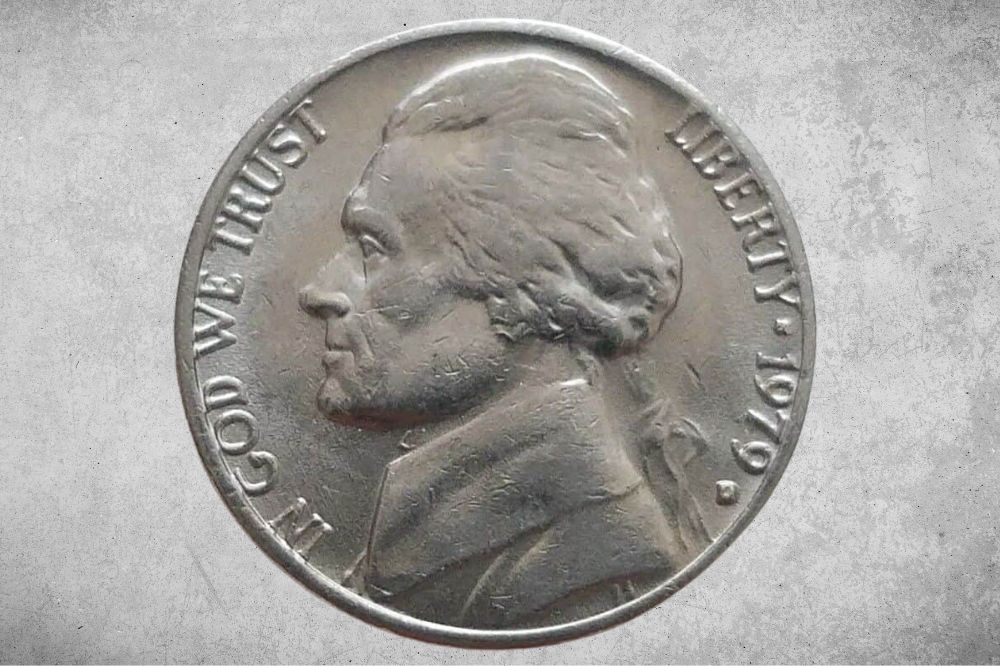Nickels have a long history and a strong design, and the 1979 nickel is no exception. While this coin features the Jefferson front and mansion back that many picture by default, this year carries a few unique characteristics worth a premium.
The 1979 nickel has two different versions of its proof nickel that are worth over 40 to 100 times the face value of the coin, but business strike coins can be worth much more than that if found in mint condition.
This guide expands on the appearance of the coin, the different types available, and how to identify the value of the 1979 nickel. We also touch on the history of the coin and a few commonly asked questions.
1979 Nickel Details
- Category: Jefferson Five Cents (1938 to 2004)
- Mint: Philadelphia; Denver; San Francisco
- Mintage: 792,732,847
- Obverse Designer: Felix Schlag
- Reverse Designer: Felix Schlag
- Composition: 75% Copper; 25% Nickel
- Weight: 5 grams
The 1979 nickel hit production in the middle of the Jefferson Five Cent series. On the front of the coin, a bust of third President Thomas Jefferson faces the left, and the inscription IN GOD WE TRUST climbs up the left curve.
The word LIBERTY reads down the right, followed by the year 1979 with a star separating the two. If the coin was minted in Denver or San Francisco, the mint mark sits tucked under the year.
The reverse of the 1979 nickel features a front view of Jefferson’s mansion, identified by name by the MONTICELLO inscription below. The U.S. motto E PLURIBUS UNUM reads across the top curve, and the denomination FIVE CENTS is inscribed underneath the image.
The coin reads UNITED STATES OF AMERICA along its bottom rim.
1979 Nickel Value Chart |
|||||
| Mint Mark | Good | Fine | Extremely Fine | Uncirculated | Proof |
| 1979 No Mint Mark Nickel Value | $0.05 | $0.05 | $0.28 | $4.52 | / |
| 1979 D Nickel Value | $0.05 | $0.05 | $0.28 | $4.63 | / |
| 1979 S Proof Type 1 Nickel Value | / | / | / | / | $2.33 |
| 1979 S Proof Type 2 Nickel Value | / | / | / | / | $5.84 |
1979 Nickel Value and Varieties Guide
There are technically 3 types of the 1979 nickel, but numismatists identify two subtypes in the proof coin. These nickels were produced in Philadelphia, Denver, and San Francisco, and they carry a value that relates to the scarcity of high-quality coins from each mint.
1979 No Mint Mark Nickel Value
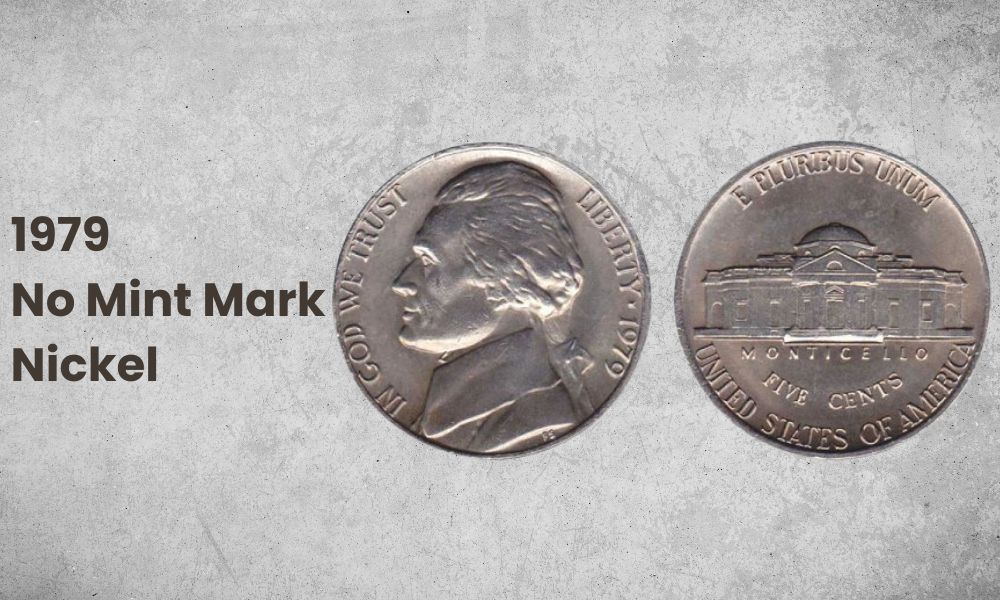
- Type: Jefferson Five Cents (1938 to 2004)
- Edge: Plain
- Mint Mark: N/A
- Place of Minting: Philadelphia
- Year of Minting: 1979
- Face Value: $0.05
- $ Price: $0.05 to $4.52
- Quantity Produced: 463,188,000
- Designer: Felix Schlag
- Mass: 5 grams
- Diameter: 0.8348 inches (21.2 mm)
The no mint mark 1979 nickels from the Philadelphia mint are the largest in circulation, and therefore carry the lowest market value. Most everyday circulated coins are only worth their face value.
If you come across an “Extremely Fine” P nickel, you may find a buyer willing to pay about $0.28 just to have it in their collection. Otherwise, you want to keep an eye out for “Uncirculated” coins that bear a value of $4.52.
Taking high-graded coins to auction provides a better opportunity for sales. The auction record for a 1979 no mint mark nickel is an MS-66-FS (full steps) that sold for $2,115 at Heritage Auctions in January 2016.
1979 D Nickel Value
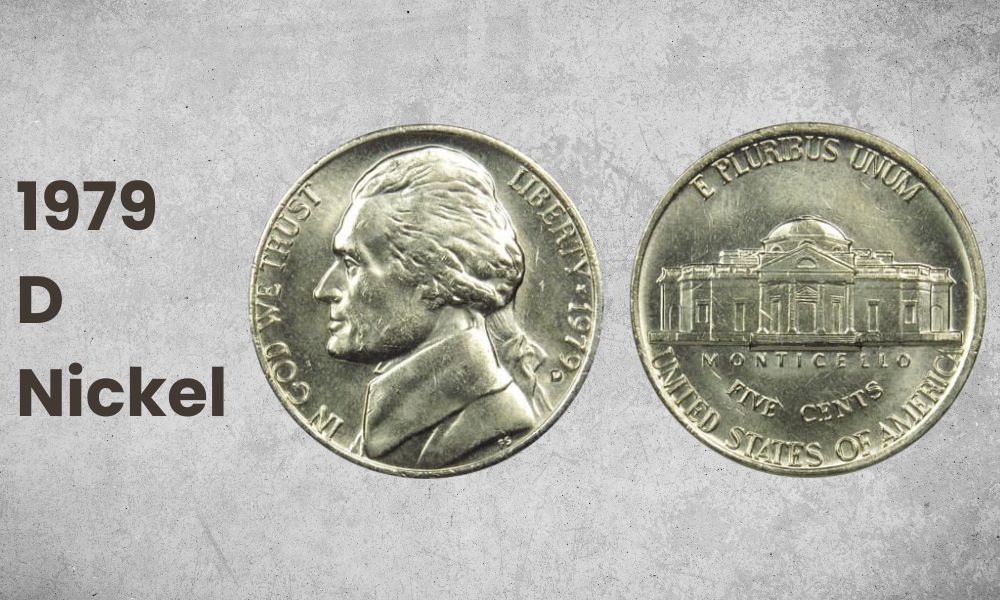
- Type: Jefferson Five Cents (1938 to 2004)
- Edge: Plain
- Mint Mark: D
- Place of Minting: Denver
- Year of Minting: 1979
- Face Value: $0.05
- $ Price: $0.05 to $4.63
- Quantity Produced: 325,867,672
- Designer: Felix Schlag
- Mass: 5 grams
- Diameter: 0.8348 inches (21.2 mm)
The 1979 D nickel is almost as plentiful as the one without a mint mark, with 3.2 million put into circulation. This makes them only marginally more valuable than the Philadelphia coins, although lesser grades only command face value.
An “Extremely Fine” d-marked nickel is worth about $0.28, while an “Uncirculated” coin brings in $4.63 or more.
An Ebay auction holds the record for this specific version of the 1979 nickel. In November 2022, an NGC graded MS-67-FS 1979 nickel sold for $4,500.
1979 S Proof Nickel Value
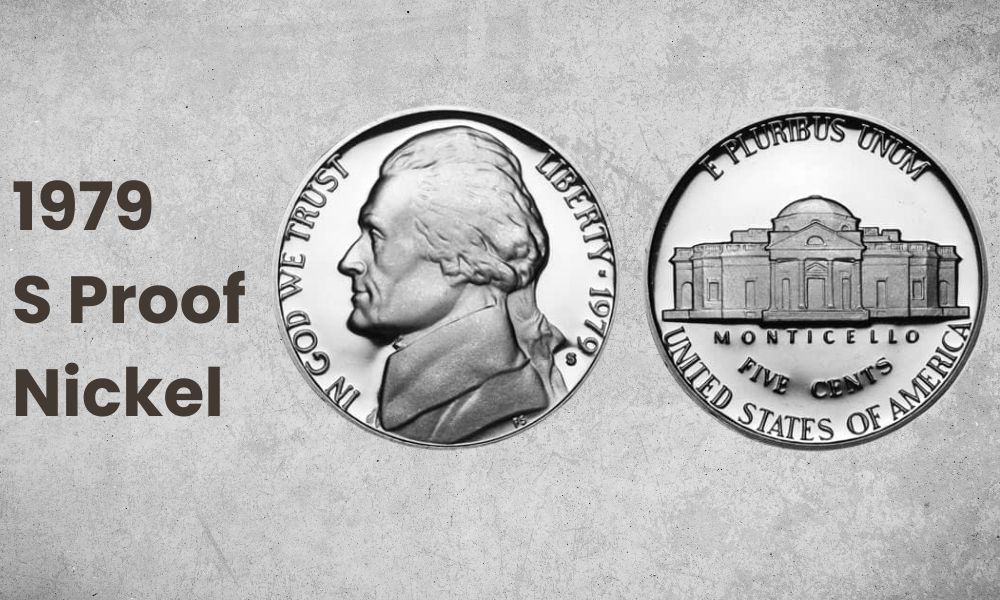
- Type: Jefferson Five Cents (1938 to 2004)
- Edge: Plain
- Mint Mark: S
- Place of Minting: San Francisco
- Year of Minting: 1979
- Face Value: $0.05
- $ Price: $0.05 to $3.50
- Quantity Produced: 3,677,175
- Designer: Felix Schlag
- Mass: 5 grams
- Diameter: 0.8348 inches (21.2 mm)
The 1979 proof nickels are marked with an S to show mintage in San Francisco, but there are two types that carry different values. While both coins are shinier and included in the 3.6 million produced, it’s unclear how many of each type exist.
The first type is a filled S proof coin. The mint mark is partially filled, not as pronounced, and considered more common than the second type. These coins regularly sell for $2.33 or more, but the auction record sold for $1,763.
The second type, which is more rare, features a clearer S mark on the coin. These usually sell for about $5.84. The auction record for the Type 2 S Proof 1979 nickel is a PR-70 that sold for $2,530 in 2008.
Also Read: 15 Most Valuable Nickels Worth Money
1979 Nickel History
The design of the 1979 nickel comes from the Felix Schlag design intended to honor Thomas Jefferson. The obverse profile is based on a Gilbert Stuart portrait, while Monticello on the reverse highlights the home of the founding father.
This particular design is well-recognized, and few adjustments were made over the years. The only one of note is the composition changes during World War II so the nickel could be redistributed to war efforts.
It wasn’t until 2004 that the Jefferson nickel made way for the Westward Journey series, but the design returned to Monticello in 2006.
Also Read: Top 110 Most Valuable Nickels Worth Money
1979 Nickel Grading
A 1979 nickel is not particularly coveted, and plenty of these coins have seen heavy circulation. In fact, you’re likely to find them in coin rolls and cash registers even now. Because of this, many coins are of lower quality and do not carry a premium.
Collectors can still find high-grade coins at a decent value, and your focus should be there when buying or selling coins. Professional grading from PCGS or NGC is essential for major transactions, but training your eye is a good tool when you’re on the lookout.
A Note on Full Steps Jefferson Nickels
A “Full Steps” grading on a Jefferson nickel refers to how many steps are apparent at the entrance to Monticello on the reverse.
The reverse of these coins is known for a weak die strike, and these coins sometimes lack the full intended details. A professional FS grade goes beyond the 70 point scale to verify that there are 5 or 6 entirely visible steps.
These coins hold a much higher value than weakly struck 1979 nickels, and they often sell for $60 to $900+ depending on mint mark on other conditions.
Good
A Jefferson nickel in “Good” condition resembled what you may see in your pocket on any given day. When 1979 nickels reach this point, they lack the full details of the coin’s design.
Jefferson’s profile is reduced to a silhouette, and other medium or high relief areas are worn down considerably. On the other side, the Monticello mansion is simply an outline on a flat foundation.
Fine
The 1979 nickels in “Fine” condition have better outlines than lesser grades, but areas of high relief are still heavily affected.
This includes smoothing on Jefferson’s hair, and his collar fades considerably into his shoulder. Jefferson’s face is near-silhouette, and his eye has begun to merge with his cheek.
The details on the reverse are more apparent. Key parts of the mansion are discernable, including the triangle above the Monticello entrance and the columns, but they still lack better detail.
Extremely Fine
An “Extremely Fine” 1979 nickel is more likely to catch your eye. You can tell it’s been through a few hands, but the condition of the coin doesn’t seem to reflect its age.
Jefferson’s finer details, such as his hair and outlines of his collar, remain strong. The triangle and foundation on the reverse may still show eye-catching wear, but all lines and details are apparent.
Uncirculated
“Uncirculated” 1979 Jefferson nickels are the ones to look out for. These coins appear brand new, shining bright with their original luster. Even high points are free of evidence of handling.
Spots that are the first to go, such as Jefferson’s hair or the high point of his eye and cheek, still shine evenly, and the columns on the back are in full detail and vigor.
Also Read: Top 19 Most Valuable Jefferson Nickels Worth Money
List of 1979 Nickel Errors
The 1979 nickels do not have any major recognizable mint errors, but you may come across common errors that increase the value of your coin.
When assessing value, keep in mind that grade comes before error and plays the largest part in the ultimate value of a coin. A rare error at a low grade often isn’t worth much at all.
1979 Off-Center Nickel
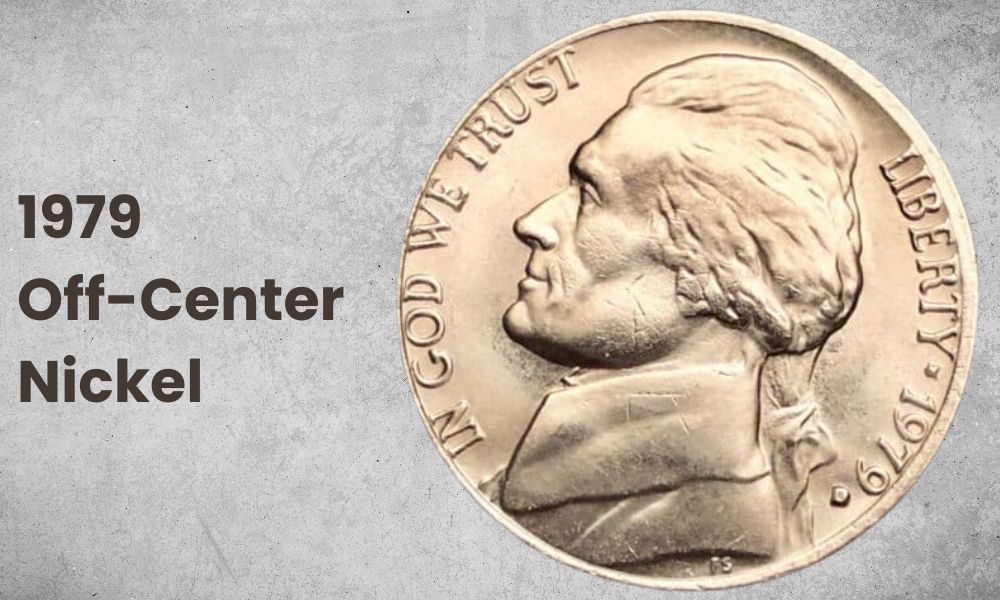
An off-center 1979 nickel usually happens when the die strikes a planchet that is not properly aligned. These coins are missing part of their design to a certain degree, usually about 3 to 10 percent.
Smaller errors may not be worth much more than the original value of the coin, but coins off center by 50 percent or greater attract a much higher premium. As long as you can see the mint mark and date, you may sell one of these coins for $100 or more.
1979 Broadstrike Nickel
A broadstrike error occurs when the circular die that holds the shape of the coin breaks, allowing the coin to spread and distort once it is struck.
These coins bear all their details, but they appear wider than normal and lack the definition you expect around the rim of a 1979 nickel.
1979 Nickel Planchet Errors
Planchet errors are a broad category of issues a 1979 nickel may have encountered during production. In short, these involve a defective blank at the mint, such as the use of a blank planchet on the coin.
While wrong planchets are obvious (and we expand on a more common example later), clipped planchets are commonly mistaken for post-mint damage. You need professional verification to market this error and attribute a value based on the error.
1979 Die Clash Nickel
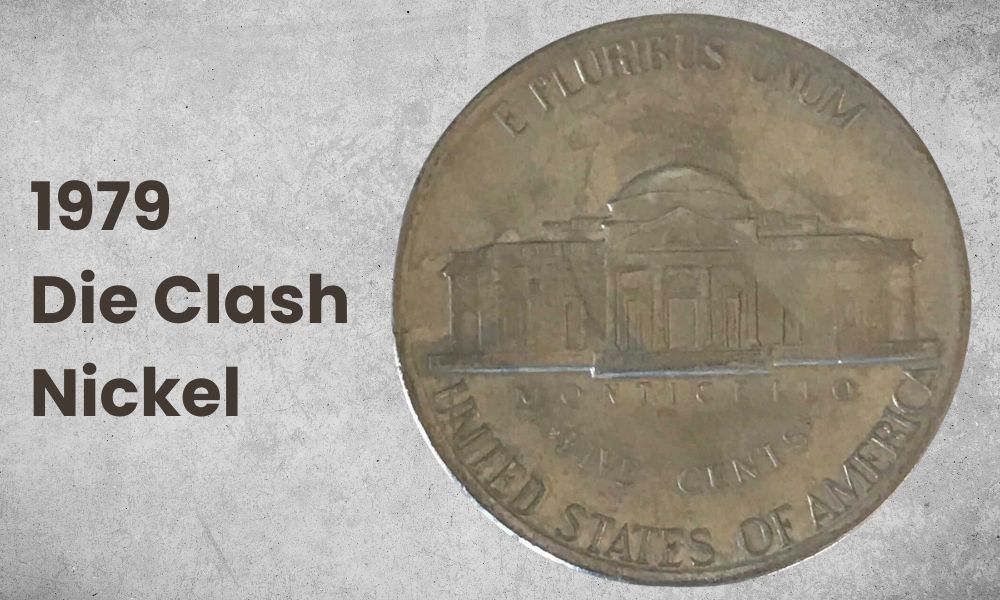
Die clashes happen when two dies strike each other without a planchet between them. The high impact causes the design of one part of the die to impress on the other, leaving the 1979 nickel with an odd surface design as the opposing side peeks through.
1979 Brokerage Nickel
A brokerage 1979 nickel is one that doesn’t fall out of the tray. A new planchet then falls between the coin and the die. When the die strikes the new planchet, it leaves the image on one side and the previously struck coin pressed on the other.
Collectors prefer brokerage coins that overlap completely, but the more common off-center ones are acceptable.
1979 Nickel Struck on Penny Planchet
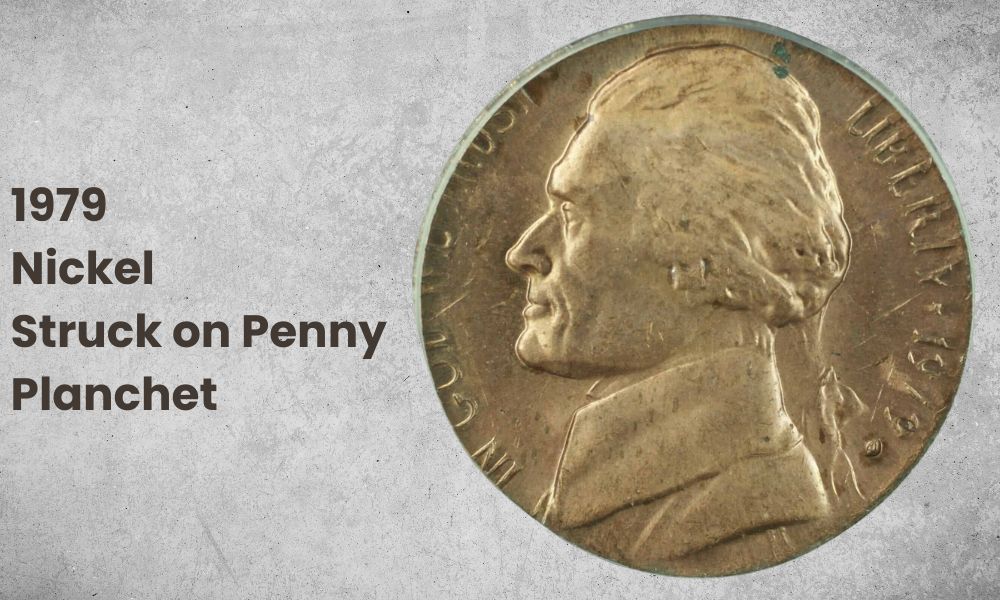
The 1979 nickel isn’t as prone to this error as other years, but a few coins have shown one struck on a penny planchet.
With this error, the blanket plates of the previously minted nickel remained on the containers and was then struck with a penny planchet on the reverse.
1979 Nickel FAQs
Where Is the Mint Mark on a 1979 Nickel?
The mint mark on 1979 nickels is located on the obverse, to the bottom left of the year. Nickels from the Philadelphia mint do not have a mint mark.
How Much Is a 1979 Nickel Worth?
Most circulated 1979 nickels are only worth their face value, but uncirculated coins may be worth about $0.25 to $5. Proof coins are worth about $6 or $2, depending on which type you find. As with most coins, highly graded examples may sell for thousands at auction.
What Is a 1979 S Proof Nickel Worth?
The 1979 S proof nickel has two types of different worth. The Type 1 1979 nickel with a filled “S” is worth about $2, while the Type 2 1979 proof nickel with a clear “S” is worth about $6.
What Makes 1979 Nickels Rare?
Nickels from 1979 remain high in circulation, but certain errors and proof coins are more rare than others. Like most coins, the most rare 1979 nickels are those with recognizable errors (such as a nickel struck on a penny planchet) and those in uncirculated condition.
